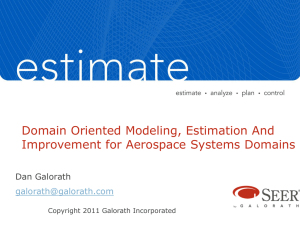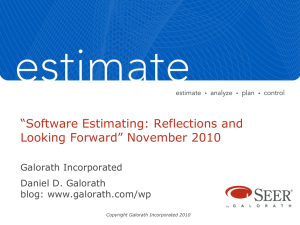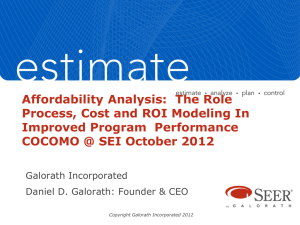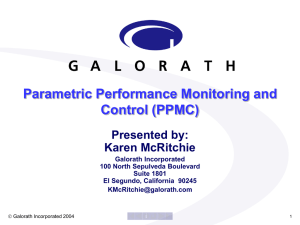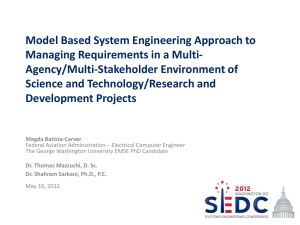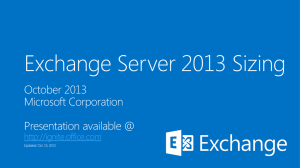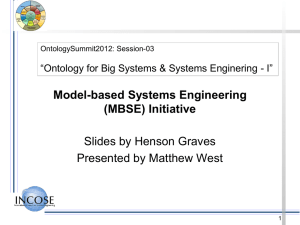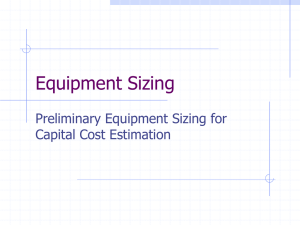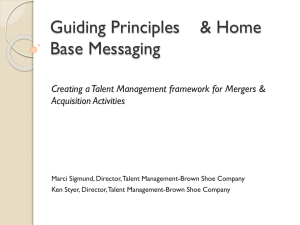Modeling *Should Cost* and *Will Cost* Using Model
advertisement
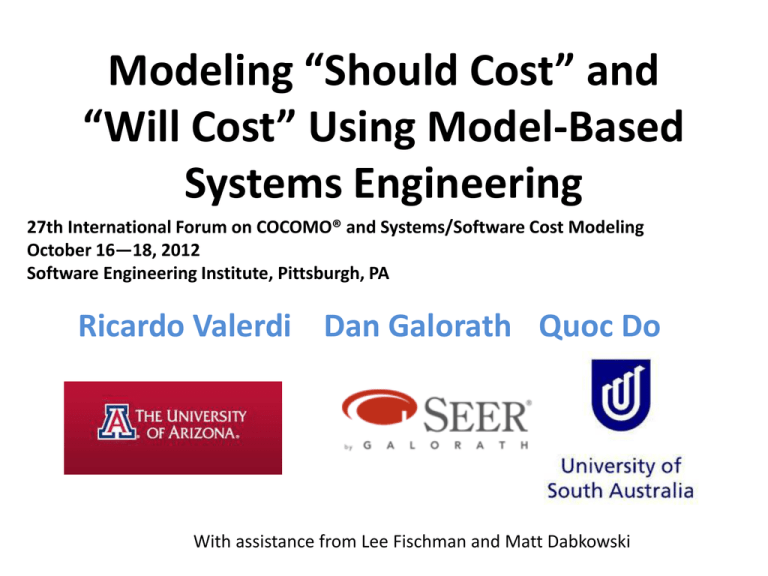
Modeling “Should Cost” and “Will Cost” Using Model-Based Systems Engineering 27th International Forum on COCOMO® and Systems/Software Cost Modeling October 16—18, 2012 Software Engineering Institute, Pittsburgh, PA Ricardo Valerdi Dan Galorath Quoc Do With assistance from Lee Fischman and Matt Dabkowski Outline • • • • • • Will-cost vs. Should-cost Model-Based Systems Engineering DoDAF views Network science Use cases Model integration examples Will cost Should cost The budget Program baseline execution target See Ashton Carter Initiatives (2010) Model Based Systems Engineering INCOSE Definition • “formalized application of modeling to support system requirements, design, analysis, verification, and validation, beginning in the conceptual design phase and continuing throughout development and later life cycle phases” • Advantages – Project information can be readily shared within large, complex projects – changes can be easily accommodated – Comprehensive traceability can be automated. Model-Based Systems Engineering Future Past • Specifications ATC • Interface requirements Pilot Airplane Request to proceed Authorize Initiate power-up • System design Power-up Report Status Direct taxiway • Analysis & Trade-offs • Test plans Moving from Document centric to Model centric Parametric estimating from natural model artifacts Initiate Taxi Executed cmds Challenges • Estimating from models themselves – Some existing successes e.g. • Galorath estimates from use case diagrams • Galorath initial integration of SEER to Rational Rhapsody • Upgrades are key activities in large long-lifetime systems of preexisting in-service components • Producing accurate, robust and realistic system upgrade plans remains a challenge • Estimating is very costly and time consuming – Development, Total Ownership, Risk • Affordability trades are cumbersome and often limited by time & resources System Modeling Requirements Functional/Behavioral Model Start Shift Accelerate Brake System Model Engine Transmission Transaxle Structural/Component Model Performance Model Control Input Power Equations Vehicle Dynamics Mass Properties Model Structural Model Safety Model Cost Model Other Engineering Analysis Models Integrated System Model Must Address Multiple Aspects of a System Page 7 Example SV-2 Systems Resource Flow Description (Hause 2011) Used with permission. SV-2/SvcV-2 [System] Control System [SV-2] «System» «block» Control System VP : Video Data VP CS->VP:VD : Video Data VP->TFC:VD : Video Data «SystemRole» TFCSW : Traffic Flow Calculation SW CS TRG «SystemRole» VPSW : Video Processing SW «SystemRole» DBSW : Display Board SW TFC TRG->DB:TR : Traffic Report SP TRG TE SP->TFC:SD : Sensor Data FC->TRG:TF : Traffic Flow WebP DB->CS : Traffic Status Message CS TFC DB «SystemRole» SPSW : Sensor Processing SW DB TDA TRG->TDA:TR : Traffic Report RG «SystemRole» TDA : Traffic Data Archive SW «SystemRole» TRGSW : Traffic Report Generation SW TFC TP Web TC TFC->TE:TF : Traffic Flow SP->TP:SD : Sensor Data TE SP TRG->TC:TR : Traffic Report «SystemRole» TC TESW : Traffic Event SW VP->Web:VD : Video Data «SystemRole» TPSW : Traffic Prediction SW TRG->Web:TR : Traffic Report VP Web CS TE->TC:AER : Accident Event Report TRG TRG TS «SystemRole» WebPSW : Web Presence SW TE TP : Sensor Data CS CS->TP:SD : Sensor Data WP WP->TP:WR : Weather Report «SystemRole» TCSW : Traffic Control SW TP ES «SystemRole» WPSW : Weather Processing SW Web->CS:TR : Traffic Report CS WP : Weather Report CS->WP:WR : Weather Report TC->TS:TSS : Traffic Signal Schedule «SystemRole» TSSW : Traffic Signal SW TC «SystemRole» TDSW : Traffic Display SW CS [System] Control Room [SV-6] TC «SystemRole» ESSW : Emergency Services SW TS->CS:TSS : Traffic Signal Schedule [Architectural Description] Resources [SV-3] TS [Architectural Description] System Activities [SV-4] CS ES->CS:SR : Service Request CS->ES:SS : Service Status ES MBSE, Cost Analysis and Network Science • • • • • • As MBSE matures, relationships between cost, schedule & performance can be determined DoD Architecture Framework (DoDAF) as an example Systems View - treated as networks, they can be mathematically analyzed – providing additional summary metrics that might yield valuable insight into the degree of effort (i.e., cost) required to bring a system to fruition. – For example: if the addition of a new subsystem can be abstracted to the addition of a vertex to a network, Can apply contemporary methods from network science to grow the network and estimate its cost. And provide an objective way to quantify and assess change Then can turn MBSE knowledge into computational knowledge supporting – Tradeoffs – Change impact analysis – related analysis early in the life cycle Network Science SV3 for a hypothetical system network science: Concerned with modeling and analyzing the connections (or edges) that exist between a network’s components (or vertices), MBSE Cost Use Cases • What is the cost impact of adding more requirements? • How do requirements volatility and uncertainty impact cost? • Which are my highest value capabilities in terms of cost-per-functionality (i.e., bang for the buck)? • What are the cost impacts of delaying, reducing, or eliminating certain capabilities? • How does schedule compression influence program cost? Galorath Prior Work By Criticalmass: SEER IBM RSx / ROSE Integration… Extracts Use Case Points from Models A weighted count of actors and use cases. • Use Case weight is automatically classified as: – – – • Actor weight is user-classified as: – – – • 5 – Simple : 3 or fewer steps 10 – Average : 4-7 steps 15 – Complex : more than 7 steps 1 – Simple : highly defined and elemental, such as a simple API call 2 – Average : user-driven interaction, allowing some freedom 3 – Complex : potentially complex interaction “Traditionally” UUCPs are calculated for an entire system; the IBM RSA Integration calculates them per use case The ‘weight’ of this actor is shared between two use cases. In this way, the summed UUCP count is comparable to the traditional method of counting UUCPs at a high level only. Galorath Prior Work: Model Based Estimating Estimating from artifacts documents to help remove the early ‘cloud of uncertainty’ surrounding projects. Automatic methods introduce less bias and better handle the ‘iceberg’ of unrecognized system size. An automatic method helps eliminate a labor-intensive and error-prone early sizing / estimating chore. 13 Provides :another arrow in the quiver” of sizing techniques Ó Galorath Incorporated 20012 CriticalMass Software Sizing From Models For Improved Early Software Sizing www.galorath.com Requirements To Size Software Descriptions Multiple Uses Use Case UML Structured Requirements Expert Sizing System Metrics Size Estimate • • • • SEER Cost / Schedule Size Estimation from DOORS Requirements Uses parsing, repository, patterns, and relative sizing Learning from user data desirable Size data required… Allocation to requirements highly desirable Relative Analysis Software Sizing From Repository • • • • • Information stored in repository for relative or absolute size estimation Baseline size, application, platform, reuse kinds of data Any size data required FORECAST SIZE AT COMPLETION via convergence of size and plans from repository Relative sizing (SEER-AccuScope) Ó Galorath Incorporated 2004 UML To Size • • • • Size estimation from UML and automated extraction from Rational Rose Uses NUCs (Normalized Use Case measures) Learning from user size data desirable Size data required… Allocation to use cases highly desirable 14 CriticalMass for Rose / UML User Enters Use Case… Chart Is Read In A Machine-Readable Format… CriticalMass UML Estimates Desired Metric T his use case w ill describe the steps required to run N orton D isk D octor. T he purpose for running this is as follow s: N orton D isk D octor diagnoses and repairs a variety of disk problem s. It perform s several tests, checking everything from the disk's partit ion table to its physical surface. If N orton D isk D octor finds a problem , it notifies you before m aking repairs. If you check A utom atically Fix E rrors, N orton D isk D octor m akes the necessary repairs autom atically. A fter diagnosing and repairing a disk, N orton D isk D octor displays an easy-to-read report that lists the problem s found, the problem s fixed, and the areas of the disk that checked out okay. 1. Actor(s) 1.1 IT Support C lerk 2. Flow of E vents 2.1 B asic F lo w 2.1.1 IT Support C lerk selects D iagnose. 2.1.2 System exam ines disk for errors 2.1.3 System displays results 2.1.4 IT Support C lerk confirm s results 2.1.5 E nd of U se C ase. 3. Alternative Flow s 3.1 C o n tin u in g fro m 2.1.2 - S ystem id en tifies erro rs o n th e d isk 3.1.1 System identifies errors on the disk and displays fix option 3.1.2 IT Support C lerk chooses to correct errors 3.1.3 System corrects errors and displays results. 3.1.4 E nd of use case 3.2 C o n tin u in g fro m 2.1.2 - S ystem id en tifies erro rs o n th e d isk 3.2.1 System identifies errors on the disk and displays fix option 3.2.2 IT Support C lerk chooses not to fix errors on disk 3.2.3 System skips fix and displays results. 3.2.3 E nd of U se C ase 4. S pecial R equirem ents 5. P re-C onditions 5.1 System navigated from N orton System W orks to N orton U tilities to N orton D isk D octor 5.2 N orton D isk D octors is correctly installed on P C 6. P ost C ondition 6.1 N orton D isk D octor closed and System returns to idle condition 15 Ó Galorath Incorporated 2004 XXXXX lines of code YYY unadjusted function points ZZZ object measures Today’s MBSE Environments And others… SEER Profile Is Integrated Into Rhapsody © 2011 Copyright Galorath Incorporated SEER Estimate Is Generated On Demand © 2011 Copyright Galorath Incorporated Rhapsody Model Exported To SEERH for Additional Analysis © 2011 Copyright Galorath Incorporated SEER-H and Rhapsody, Side By Side © 2011 Copyright Galorath Incorporated 20
